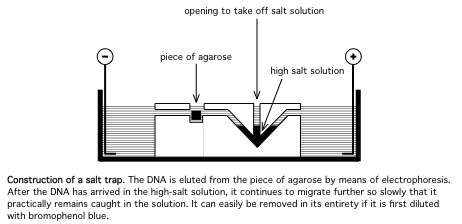DNA-Electroelution
Principle
This protocol describes the purification of DNA by trapping in a high-salt cushion in a "UEA AnalyticalElectroeluter" (IBI). This machine is no longer manufactured, to our knowledge. However, a smiliar device can be easily made from Plexiglas according to the following diagram, taken from Cornel Mulhardt, Molecular Biology and Genomics (2007) Academic Press, p.52:
 The nucleic acids contained within the gel slice are electrophoresed out of the gel, funneled down into the v-shaped channel and trapped within a high salt cushion resting at the bottom of the channel. Alcohol preciptiation of the nucleic acid in the high-salt cushion yields material suitable for subsequent enzymatic, chemical or biological manipulations.
The nucleic acids contained within the gel slice are electrophoresed out of the gel, funneled down into the v-shaped channel and trapped within a high salt cushion resting at the bottom of the channel. Alcohol preciptiation of the nucleic acid in the high-salt cushion yields material suitable for subsequent enzymatic, chemical or biological manipulations.
Instructions
1. Fill with buffer making sure the clamp on the drain hose is closed, the other two clamps open. Buffer: 20mM Tris HCl, pH 8.0, 5 mM NaCl, 0.2 mM EDTA. You need approximately 600 mLs, room temperature.
2. Remove bubbles from v-shaped channel if any form.
3. Lay gel slices in circular well. Briefly soaking the gel slices in elcetroelution buffer to remove electrophoresis buffer will reduce the required eletroelution time but it is not necessary. Electroelution has proved to be more efficient from thin gels. A gel thichness of less then 2 mm is recommended.
4. Adjust buffer level. The height of the electroelution buffer should be just at or even a bit lower than the top of the gel slices. Buffer on top of the gel slices will reduce the efficiency of electroelution. Close the other two clamps after level is adjusted. At this point the apparatus should be where you want to do the electrophoresis since you can't be walking around the room with the thing after you load the salt cushion.
5. Load salt cushion. 75 ul of 3M sodium acetate per slot. Adding just a trace of bromophenol blue of the 3M sodium acetate makes the salt cushion visible. Loading the salt cushion with a glass micropipette instead of a pipettman is recommended in order to form a well-defined buffer-high salt interface.
6. Don't bump.
7. Electroelute at 125-150 v for 50 min. This is sufficient to elute large fragments from either agarose or polyacrylamide gels without loss of smaller framents which elute much sooner (30 minutes is sufficient for oligonucleotides, for instance). Electroelution longer than 1 hr reduces the effectiveness of the salt cushion. Voltages higher than 150 volts are not recommended because of heat generation in the v-shaped channels which causes bubble formation.
8. Recovering nucleic acids: Turn off power supply. Open the two upper clamps first, then slowly open the drain hose clamp. When the buffer level has dropped below the slices in the well you can remove the salt cushion. Remove all the liquid in the v-shaped channel with a pasteur pipette and precipitate with ethanol (2-2.5 volumes).
9. Cleaning. Many procedures demand nucleic acids free of other contaminating nucleic acids. It is recommended that the v-shaped channels be electrophoretically cleaned immediately after using the apparatus. Simply remove the gel slices, refill the channels and wells with buffer and run for a while. Discard buffer, rinse with distilled water and store dry.
Last Update: Thursday June 19 2014
This page has been viewed Failed to execute CGI : Win32 Error Code = 2
times.
Eric Kofoid
eckofoid at ucdavis.edu

